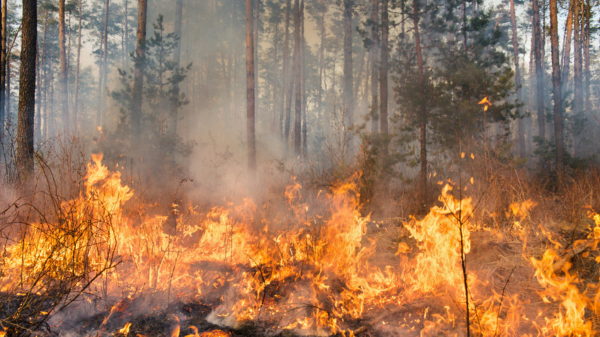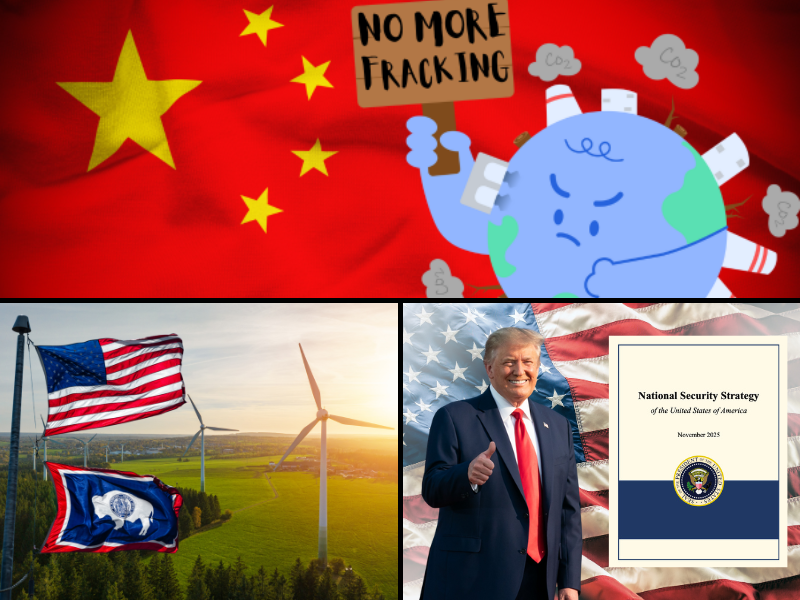IN THIS ISSUE:
- Paris Climate Treaty Is Going Down
- Mexico’s Emissions Cheat
- Wildfire Severity Is Unusually Low, Study Calls It a Deficit

Paris Climate Treaty Is Going Down
With history as a guide and two months to prepare for the announcement, there was relatively little wailing and gnashing of teeth when President Donald Trump withdrew the United States from the Paris Climate Agreement (for the second time; the lamentations were much greater in 2017) on his first day back in office. Despite efforts by politicos and influentials within the United States and internationally to encourage Trump to stay in the Paris agreement, the writing was on the wall.
Trump has repeatedly called climate change a hoax and the green new deal a scam. Trump’s words might indicate his assessment of the nefarious shenanigans that climate researchers have been caught undertaking over the years and the half-truths and falsehoods those climate researchers have peddled in the effort to gain more funding for themselves and influence political action. Alternatively, Trump’s statements might have been signaling his deft understanding that the Paris agreement took America as a sucker and were an attempt to force the United States and developed nations to deindustrialize while our geopolitical and economic rivals, especially China, India, and Russia, continue developing using fossil fuels. Regardless of his motives, Trump said he’d pull the United States out of the Paris agreement (again!), and he did. I hope it will stick this time.
Trump went even farther, however, signing the Putting America First in International Environmental Agreements EO. This order rescinded America’s support for every climate agreement subsequent to the initial U.N. Framework Convention on Climate Change treaty the United States joined through Senate ratification in October 1992. These include, for example, the 1997 Kyoto Protocol (1997), the 2001 Adaptation Fund (2001), the 2007 Bali Action Plan, the 2009 Copenhagen Accord, the 2013 Warsaw International Mechanism for Loss and Damage (2013), the Lima-Paris Action Agenda (2014), and the 2024 New Collective Quantified Goal on Climate Finance.
Trump explained why the EO was necessary, writing,
In recent years, the United States has purported to join international agreements and initiatives that do not reflect our country’s values or our contributions to the pursuit of economic and environmental objectives. Moreover, these agreements steer American taxpayer dollars to countries that do not require, or merit, financial assistance in the interests of the American people.
Even before Trump’s move, the Paris agreement was on the rocks. As I wrote back in 2017, it was doomed to fail, in structure and substance, from the start:
Even if all parties to the agreement met their commitments, by most honest analysts’ reckonings the increase in Earth’s temperature would exceed the 2 degrees Celsius the parties to the agreement argued was necessary to prevent disastrous consequences.
Now, even the United Nations (UN) is ‘fessing up to this fact.
An October 31, 2017 UN Environment Programme (UNEP) report finds even if every country abides by its Paris commitments to cut or cap greenhouse gases between now and 2030, a dubious proposition at best, temperatures will still rise by 3 degrees C by 2100.
To be clear, the 2.0℃ was the absolute maximum, with 1.5℃ being the much-desired cap. Ignoring the fact that the longest, consistently maintained and monitored temperature measuring station suggested we had already exceeded two degrees at the time Paris was signed, certainly 2024 signaled Paris’s failure, with numerous alarmists taking to the mainstream media outlets to proclaim the 1.5 tipping point/threshold had been exceeded every month for more than a year. No disaster has become evident yet, despite all the warnings, but just you wait, say the Paris promoters: if prompt action isn’t taken now, catastrophic climate change really is coming, and they mean it this time.
Alarmists’ prognostications have never been right.
With this in mind, what are we to think about other Paris climate agreement news related to other governments’ climate actions?
The BBC is reporting a number of countries party to the Paris climate agreement are openly discussing not keeping their commitments, without officially withdrawing from the treaty. Argentina, Indonesia (a top ten global CO2 emitter), South Africa (Africa’s largest emitter), and South Korea, among other countries supposedly committed to reining in fossil fuel use and cutting their emissions, are now openly saying they will explore for and exploit their domestic reserves of coal, natural gas, and oil, and going further, they say they hope to import those products from the United States.
At least some of those countries’ leaders are blaming Trump for their “new” stance on fossil fuels.
“If the United States does not want to comply with the international agreement, why should a country like Indonesia comply with it?” said Hashim Djojohadikusumo, Indonesia’s special envoy for climate change and energy, recently. “Yet we are the ones being told to close our power plants. … So, where is the sense of justice here?”
Djojohadikusumo, and anyone else who blames the United States for backsliding on an agreement they remain a party to, are shedding crocodile tears. Every single country now saying they want more fossil fuels was, in fact, increasing its use of fossil fuels long before Trump was reelected, and well before he pulled the United States out of Paris. In fact, no country that set specific targets for emission reductions in the first Paris commitment period has made significant progress toward meeting its goals. None, nada, zilch.
Further evidence the Paris agreement is dead has been reported by Yahoonews.com. Of the nearly 200 countries that signed the Paris agreement, only 10 submitted their updated carbon-reduction commitments by the time called for, February 10. That makes 190 scofflaws. Also, even those ten have failed to meet their previous carbon reduction commitments. One wonders why they bothered to set stricter goals when they failed to meet their previous ones and weren’t even going in the right direction.
As the Yahoo story reports,
Under the climate accord, each country is supposed to provide a steeper headline figure for cutting heat-trapping emissions by 2035, and a detailed blueprint for how to achieve this.
Global emissions have been rising but need to almost halve by the end of the decade to limit global warming to safer levels agreed under the Paris deal.
UN climate chief Simon Stiell has called this latest round of national pledges “the most important policy documents of this century”.
Yet just a handful of major polluters handed in upgraded targets on time, with China, India, and the European Union the biggest names on a lengthy absentee list.
The Paris climate treaty has no enforceable penalties. It was a paper tiger from the start.
Philosopher Thomas Hobbes, in a wonderful turn of a phrase centuries ago, aptly described in foresight the result of each and every climate agreement to date, writing in Leviathan: “Covenants, without the sword, are but words, and of no strength to secure a man at all.” That describes each and every climate agreement developed thus far, in a nutshell.
Sources: Yahoo.com; BBC; Climate Change Weekly

Mexico’s Emissions Cheat
Under the Paris climate treaty, Mexico made relatively modest CO2 commitments. Mexico’s leaders pledged only to reduce emissions by 22 percent compared to a self-developed business-as-usual scenario. Under that plan, Mexico’s emissions in 2030 would still be higher than they were in 2015, when Paris was signed, but they would be lower than they would supposedly have been otherwise. Guess what? Mexico’s emissions have increased since 2015.
Under the 2022 commitment period, Mexico said it would now reduce emissions 35 percent below business as usual. However, as Climate Action Tracker points out,
Mexico’s climate policies continue to go backwards, as fossil fuel use is prioritized and climate-related policies and institutions dismantled. Mexico’s updated 2030 target (NDC), submitted in November 2022 results in higher emission levels than the targets from 2016, breaching both agreements under the Paris Agreement and Mexican Law—where governments committed to improve their targets over time. . . . With this update, the CAT’s rating of Mexico’s climate targets and action worsens from “Highly insufficient” to “Critically insufficient”.
While the new target includes a larger percentage reduction it still leads to higher emissions. The NDC update increases the percentage reduction of the unconditional target from 22% to 35% (30% with own resources and an additional 5% from agreed international support) by 2030 and from 36% to 40% conditional on additional international support. But the business-as-usual (BAU) baseline, against which the targets are defined, has been revised upwards. In addition, Mexico expects a higher contribution of emissions sinks in forests to achieving the target. Together this means that the new target can be met even if emissions excluding those of forestry are higher than what they could have been under the old target. …
Mexico pursues a “gross-net” approach, meaning it counts only emissions sources in its BAU, ignoring sinks from land use and forestry. However, the NDC does intend to use these sinks to achieve the target. …
Mexico’s 2022 NDC update removes the target to peak emissions in 2026 and does not mention any net zero nor other long-term targets.
Any way it’s calculated, Mexico’s CO2 emissions are growing and will continue increasing for the foreseeable future. How many other countries are pursuing similarly phony “emission reduction” plans? Surely Mexico is not the only country that’s proven sly enough to game the system.
Sources: Watts Up With That; Climate Tracker

Wildfire Severity Is Unusually Low, Study Calls It a Deficit
Research recently published in Nature Communications confirms what The Heartland Institute has reported for years: if recent wildfire trends are historically unusual, it is not for being too large or frequent but because they are much lower than occurred historically.
A team of 19 researchers from universities and research institutes in the United States, Canada, and Switzerland examined tree-ring fire scars “on individual living or dead trees, stumps, or logs … derived from multiple trees from plots … [to] incorporate the longest and most complete census of fire dates obtainable from the available material.”
Their analysis found,
Wildland fire was common and widespread across many forests and woodlands in North America prior to the late 19th and early 20th centuries. In subsequent decades, fire exclusion—the practice of preventing and suppressing nearly all wildland fires—occurred as the result of the disruption of traditional burning, livestock grazing, and active suppression of human- and lightning-ignited fires. As a consequence, average annual area burned since the late 19th and early- to mid-20th centuries is generally less than that experienced under historical fire regimes across many North American forests, resulting in a widespread 20th century ‘fire deficit’ relative to earlier time periods.
The North American tree-ring fire scar network breaks down the continent into 10 forest/fire regions. Of those regions, only “the Taiga & Hudson Plain, in Northern Canada, had had more fires in the 1984-2022 study interval than would be predicted based on the burn scar data prior to 1880.” In fact, only three regions, including the Taiga & Hudson Plain area, experienced even 50 percent of the historical norms of fires. Forty percent of the regions experienced less than 20 percent of the historical amount of fire.
The main takeaway of the study is this:
Overall, contemporary fires (1984-2022) burned NAFSN [North American tree-ring fire scar network] sites less frequently than fires during the historical reference period (pre-1880), indicating that a substantial fire deficit persists and is still accumulating across many forests and woodlands across the United States and Canada. … Based on the historical fire-scar record, NAFSN sites collectively would be expected to have burned 4346 times from 1984-2022, yet they burned 989 times, or only 23% of what would be expected under the historical fire regime.
As mentioned above, this study confirms what Climate Realism and Climate at a Glance have long reported: data conclusively proves wildfires are on the decline, both in the United States and globally, contrary to mainstream media lies.
Discussing this study at a recent Watts Up With That post, science journalist Kip Hansen noted several key conclusions one can take away from this new study:
- Claims made repeatedly in the mainstream media that wildfires are getting more common and more severe are not supported by the findings of this study.
- When looked at over the last 200 years, we have a severe fire deficit, not an excess. In the ecoregions studied (U.S. and Canada), fires have been far less frequent and the result is a fire deficit. This is true of all the ecoregions except the most northern parts of Canada.
- The long-term fire deficit, unburned wildlands, sets up wildlands for more fiercely burning fires that consume all the extra fuel left by the lack of fire.
Hansen’s third point suggests a valuable policy option: increased logging in the forests to reduce the overabundance of fuel, including expedited salvage logging of dead, dying, and fallen trees. This action would produce a valuable product, improve forest ecosystem conditions, and set them up for controlled burns to clear brush and forest litter, reducing the severity of future wildfires when they do occur.
Sources: Watts Up With That; Nature



